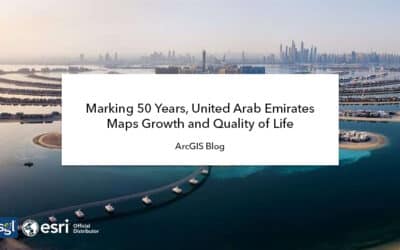Esri News: What 2019’s Smartest Cities Have in Common
London and New York are the world’s smartest cities, according to the 2019 Cities in Motion Index (CIMI), issued by the IESE Business School. The index ranks 174 cities across nine dimensions: human capital, social cohesion, the economy, governance, the environment, mobility and transportation, urban planning, international outreach, and technology.
Many of the smartest cities on the list use location intelligence to help civic leaders and executives create data-driven performance, operational efficiency, and situational awareness and plan long-term improvements that benefit all residents.
Many of the smartest cities on the list use location intelligence to help civic leaders and executives create data-driven performance, operational efficiency, and situational awareness and plan long-term improvements that benefit all residents.
Location Intelligence: Building Smart
As IDC analyst Alison Brooks put it in a recent podcast, location is the grammar of smart cities. In the face of complex challenges such as homelessness, mobility, pollution, and aging populations, leaders of the world’s smartest, most sustainable cities are combining location-based technologies with human ingenuity to improve living and working conditions.
Six of the CIMI dimensions for measuring smart cities benefit from the introduction of location intelligence:
Environment—As they do in San Francisco (#21 on the CIMI), smart city planners can model potential buildings and predict short- and long-term impacts on the environment. Conservationists can choose where best to incorporate green spaces or plan conservation projects, as well as analyze air quality and spot its causes in different areas of the city.
Governance—City agencies often use location technology called a geographic information system (GIS) to share data across silos and operate more efficiently. Los Angeles (ranked #16 on the CIMI) created a dedicated information hub to centralize the city’s open data and communicate with citizens about smart city initiatives.
The Inner Workings of Location Intelligence
Location data helps cities get smart and businesses make better decisions. See what that looks like in practice in this e-book on location intelligence.
“When LA began to organize all of its open data with the [geo]spatial tag, it allowed great insight across the department,” said Harvard professor and former Indianapolis mayor Stephen Goldsmith in a recent podcast. “So now the departments can see each other’s data located in a sense of place.”
Industry-leading businesses have taken a similar approach to data, believing that information reaches its full potential when it is democratized.
Human Capital—Strategists and business leaders can analyze the demographics of a city’s population and use that insight to plan improvements that attract specific talent. Some cities that fly under the radar of global business schools like IESE have done pioneering work in this area, including Bentonville, Arkansas, home of Walmart’s global headquarters.
Mobility and Transportation—Forward-leaning officials can better manage transportation systems and plan repairs with the help of location intelligence. For example, Metropolitan Transit Authority executives in New York City (#2 on the CIMI) use GIS to manage $1 trillion in assets and plan long-term improvements for the country’s busiest subway. Meanwhile, Paris (#4) uses IoT-based applications to optimize the flow of traffic in the city, and Singapore’s autonomous taxis rely on virtual maps as a source of truth.
London (#1 on the CIMI) built autonomous vehicles to enhance mobility at busy Heathrow Airport and combined GIS with building information modeling (BIM) technology to undertake Crossrail, Europe’s largest construction project. Crossrail executives needed to know the precise locations of underground infrastructure to safely weave new tunnels through the built environment.
Urban Planning—City leaders; businesses; and architecture, engineering, and construction (AEC) firms can see how a structure will look before they decide to build it, measuring views from a virtual apartment window or the shadow of a skyscraper on a local park.
Cities such as Boston (#25 on the CIMI) are constructing 3D models of their physical infrastructure and using location data as a connective thread to experiment with virtual plans.
Technology—The CIMI calls out technology as its own dimension, but as the above examples show, technology is the backbone of many smart city initiatives. According to IESE, a smart city can be measured in part by the access its citizens have to critical communications technologies, including computers, mobile devices, and the Internet. One telecom company in Italy is working to make that access more equitable, while its peers in the US and elsewhere are using artificial intelligence to roll out the 5G networks that will power tomorrow’s smart cities.
The Business Value of Smart Cities
As cities work to become smarter and more sustainable, savvy business leaders are getting involved. Authors of the CIMI report note that the private sector is uniquely experienced and skilled in project management and technology applications and has much to contribute to smart initiatives.
Business executives can benefit from smart city projects by building better relationships with city leaders, understanding local markets more deeply, and profiting from the greater international visibility that attracts talent to their cities.
Conversely, there’s much at stake for business leaders if their host cities don’t get smarter and stay competitive. IDC’s Brooks warns of the knock-on effects to businesses in cities that aren’t improving:
The cities that don’t digitally transform to meet up with those citizen expectations and business expectations, they in fact lag in terms of economic viability across the board, so they don’t attract talent, they don’t attract businesses, and so then there’s this process of degradation and stagnation that occurs. We see the direct linkage between digitally transformed organizations, citizen satisfaction, and economic growth and viability, which altogether makes it a collective no-brainer.
Advancing Technology, Advancing Cities
Goldsmith’s perspective on smart cities is colored by the drastic technology changes experienced in the past decade.
“In the last five years, the technology breakthroughs have been just breathtaking. And the problems that now can be solved with technology were unimaginable, I mean, 10 years ago, even 5 years ago.”
It’s a good reminder that becoming a smart city isn’t really about getting a top score in a report, but about solving urban problems and making life better for every citizen and business. As many civic leaders now realize, when location intelligence meets innovation, cities and citizens get smarter.
Find your city and compare it with others in this interactive map from IESE.
Location Intelligence: Building Smart
As IDC analyst Alison Brooks put it in a recent podcast, location is the grammar of smart cities. In the face of complex challenges such as homelessness, mobility, pollution, and aging populations, leaders of the world’s smartest, most sustainable cities are combining location-based technologies with human ingenuity to improve living and working conditions.
Six of the CIMI dimensions for measuring smart cities benefit from the introduction of location intelligence:
Environment—As they do in San Francisco (#21 on the CIMI), smart city planners can model potential buildings and predict short- and long-term impacts on the environment. Conservationists can choose where best to incorporate green spaces or plan conservation projects, as well as analyze air quality and spot its causes in different areas of the city.
Governance—City agencies often use location technology called a geographic information system (GIS) to share data across silos and operate more efficiently. Los Angeles (ranked #16 on the CIMI) created a dedicated information hub to centralize the city’s open data and communicate with citizens about smart city initiatives.
ABOUT THE AUTHOR

Dominik Tarolli
Dominik Tarolli is the director of smart cities at Esri. He was named a Top 100 Digital Shaper in 2018 and co-founded Procedural Inc., the maker of CityEngine software, which was acquired by Esri. Esri’s Smart Cities team is working with forward-thinking cities and communities around the world to make them more livable and resilient every day.

